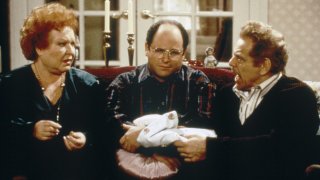
It's that Festivus time of year.
The anti-holiday holiday made famous on "Seinfeld" is celebrated annually on Dec. 23 by those who want to embrace their inner "Bah Humbug" with a secular alternative to Christmas consumerism.
And with a tripledemic of respiratory illnesses putting a damper on holiday gatherings, coupled with high inflation making gift-giving even more expensive this year, there is plenty to be grumpy about.
Among the modern-day Festivus traditions is taking to Twitter to unload pent-up resentment, anger and frustrations, with the most famous grievance threads coming annually from Republican Sen. Rand Paul, who observes the day every year by grumbling about all the government waste on social media. This year, Paul began taking Congress to task early in the week over the $1.7 trillion spending bill the Senate passed Thursday — but he noted that he's "got plenty more coming."
Feeling out of the loop? We'll catch you up on the Chicago news you need to know. Sign up for the weekly Chicago Catch-Up newsletter here.
This year, the "Seinfeld" TV show Twitter account announced it had launched an official change.org petition to make Festivus a national holiday.
But what exactly is Festivus? A look at its origins and how to celebrate it:
Entertainment News
What is the meaning of Festivus?
Festivus is a wacky holiday popularized in a 1997 “Seinfeld” episode. Billed as “Festivus for the rest of us,” the holiday is celebrated by the Costanza clan on Dec. 23 as an all-inclusive, secular alternative to Christmas consumerism.
In protest of Christmas’ commercialism, George Costanza's father, Frank Costanza, puts up an unadorned aluminum pole instead of a tree. The metal, he says admiringly, has a “very high strength-to-weight ratio.”
What is the origin of Festivus?
The “Seinfeld” Festivus episode developed from series writer Dan O’Keefe’s childhood experiences. His father invented the holiday in the 1960s.
“As a kid, we’d come home and there’d be weird decorations,” O’Keefe said in an interview with The Associated Press. “There was the playing of strange German and Italian pop music from the ’50s. And the airing of grievances was a real thing.”
Instead of a pole, his family celebration featured a clock and a bag. (O’Keefe has said his father won’t disclose what they symbolized.)
What do you eat at a Festivus dinner?
The official Festivus dish is meatloaf, according to the "Seinfeld" episode titled the "The Strike." Serve it to guests atop a bed of lettuce.
What are the stages of Festivus?
According to the "Seinfeld" model, there are four main traditions associated with observing Festivus.
The traditional Christmas tree is replaced with an aluminum pole that is decoration-free, “mainly because tinsel is too distracting,” explains Frank Costanza. Serve your guests a modest dinner of sliced meatloaf.
Once everyone is seated around the dinner table, start the "airing of grievances," in which family members and those in attendance get a chance to share pent-up feelings towards each other over the past year.
It concludes with the "feats of strength," a wrestling match that requires the pinning of the family patriarch or host by a guest in order for the party to end.



